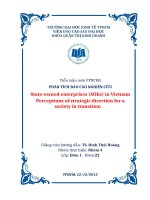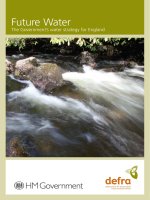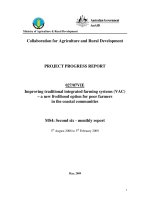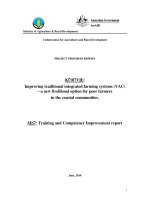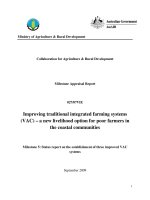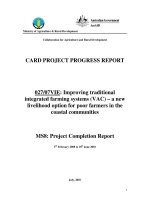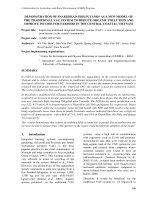VIETNAM GOVERNMENT''''S COMPENSATION POLICIES FOR SMALLHOLDER FARMERS IN HATINH PROVINCE AFTER 2010 FLOODS pps
Bạn đang xem bản rút gọn của tài liệu. Xem và tải ngay bản đầy đủ của tài liệu tại đây (549.66 KB, 82 trang )
VIETNAM GOVERNMENT’S COMPENSATION
POLICIES FOR SMALLHOLDER FARMERS IN HATINH
PROVINCE AFTER 2010 FLOODS
Le Viet Thai
Ta Minh Thao
Nguyen Minh Thao
Central Institute for Economic Management
Hanoi, 6/2011
1
CONTENT
LIST OF ABBREVIATION 12
LIST OF TABLES 13
1 LIST OF FIGURES 14
INTRODUCTION 15
2 Objectives and tasks 15
3 Analytical Framework 15
4 Methodology 17
5 Scope and Objects 19
6 Activities be conducted 20
7 Report structure 20
CHAPTER I – COMPENSATION POLICIES TO OVERCOME DIFFICULTIES
CAUSED NATURAL DISASTERS 21
1 Central compensation policies to overcome difficulties caused floods 21
1.1 Identify beneficiaries of policies of support for natural-caused losses 21
1.2 Central government support policies 23
1.3 Regulations on mobilizing sources of voluntary donations for people
affected by natural disaster 25
2 Policies on remedy for the consequences of double floods in Ha Tinh 2010 27
2.1 Central support policies 27
2.2 Local support policies 30
2.3 Disaster management cycle 32
2.4 Natural disasters and support resources in Ha Tinh according to data VHLSS
2008 33
CHAPTER II. IMPLEMENTING COMPENSATION POLICIES AT VU
QUANG AND HUONG KHE 36
1 Damage of smallholder farmers after 2010 floods 36
2 Needs of smallholder farmers aftermath of 2010 floods 38
3 Support types 40
4 Accessibility of smallholder farmers to compensation policies 41
2
5. Recovery of smallholder farmers 43
6. Local implementation capacity 48
6.1. Huong Khe district 48
6.2. Vu Quang district 50
7. Policy targets vs. Implementation results 53
7.1. Support policy 53
7.2. Policy impacts 54
7.3. Level of recovery 55
7.4. Reasons for successes and shortcomings 56
CHAPTER III. POLICY RECOMMENDATION 59
1 General recommendations 59
2 For the Central government 60
3 For the provincial People’s Committee (PPC) 61
4 For district People’s Committee (DPC) 62
5 For commune People’s Committee (CPC) 63
6 For Oxfam 65
CONCLUSION 67
REFERRENCES 70
ANNEX 1. Household Questionnaire 71
ANNEX 2. In-dept questionnaire 78
3
EXECUTIVE SUMMARY
1. Main findings
Legal framework on post-disaster policies for affected groups is fairly
comprehensive. Government stipulate specifically affected groups, support measures and
support levels, policies on rescue and production recovery as well as advocacy policies for
relief. Post-disaster recovery policies has top-down approach, thereby authorities at all
levels respond timely and quickly to minimize loss of human and assets and specially not
let the starvation happen aftermath of disaster. However, in the long run, policies on
production recovery seem to be less drastic.
Provincial government has responsibility to actively support to its affected
groups. For long-term recovery, especially for production recovery, Ha Tinh is funded
70% expenditure for disaster recovery from central state budget
1
. Besides, in case,
provincial state budget spending to affected farmers exceed 50% of its contingency budget
then central state budget will complement
2
.
Numbers of affected groups which are eligible objects to receive state supports
but Ha Tinh People’s Committee does not support, namely: (i) breeding smallholder
1
Point c, Clause 2, Artical 4 of Decision 142
2
Point d, Clause 2, Artical 4 of Decision 142
4
farmers who have less than 10 sows, or 100 pigs, or 300 egged poultry, or 500 poultry (ii)
aquatic production farmers with production area less than 02 ha and farmers who have at
least of 02 ha but damage level less than 70% or (iii) fruit and industrial crops
Expenditure for disaster recovery in a province which is regularly suffered
from disaster like Ha Tinh is a burden for provincial state budget. Observing data on
disaster in Ha Tinh during 2006-2008 from VHLSS 2008 and supports from central and
local governments show that recovery expenditure mainly put on state’s shoulder. Under
current regulations, provinces must be active to balance their post-disaster recovery
expenditure, the central government will complement only in case of facing to
extraordinary difficulties. Due to this, a difficult province like Ha Tinh in addition to
regularly happened disaster, that is a real burden for provincial government.
Damages of surveyed households were severe after 2010 floods. 5 damage types
with highest proportions of affected households are loss of cash crops (75.9%), loss of rice
crops (64.5%), loss of poultry of smallholder farmers (37.5%), loss of pigs of smallholder
farmers (29.8%) and loss of house (28.9%). If local authorities do not have appropriate
support measures for smallholder farmers then they likely fall in poverty.
Monthly total income of surveyed households tumbled after floods, and until
now it is just equal to 73% of that before floods. Monthly income reduced by half from
VND 1.9 mill to VND 0.9 million in the period of three months after floods, in which
income from agriculture reduces from VND 1.15 million to VND 0.3 million. Thanks to
various state support policies, supports from other organizations and efforts of households,
the average income has gradually recovered. However after six months the new total
income is just VND 1.4 million.
Poverty rates in Huong Khe and Vu`Quang have a dramatic increase in 2011
of all communes, the average poverty rate surging from 23.6% to 50% but we are not
able to observe direct impacts of floods on poverty. Two reasons cause this dramatic
increase. Firstly, because households are severely suffered from floods. Double floods
killed 8 persons, injured 112 person, destroyed 1028 ha of rice, 570 ha of corn, 160 ha of
sweet potato, 290 ha of vegetables cash crop, 395 tons of shrimp and fish
3
so they face
poverty. Secondly, since 2011, Vietnam apply the new poverty line, it is increased from
VND 200,000/person/per month to VND 400,000/person/per month.
Support types stipulated by Ha Tinh People’s Committee mainly have
meaning of humanitarian, while production recovery in long run is still not satisfied.
Household survey reveals that support types mainly have meaning of humanitarian (74%
of respondents), only 30.8% of respondents answered support types help to recover
agriculture production. Result of officer interviews show that 64/152 interviewees believe
3
Proposal to the Humanitarian Response to Central Floods Ha Tinh Province, Vietnam
5
that the support is not satisfactory, as people need capital to restore production; and 88/152
interviewees believe that (i) the damage was too big to make satisfactory support; (ii) so
far the level of support is the highest ever; and (iii) the support is satisfactory in terms of
hunger support.
All support types is adequately informed by local authorities, however, only
affected households who are approved by the screening procedure will receive the support.
The cultivation areas of surveyed households are nearly equal to those before
the floods mainly thank to state supports. However external conditions had negative
impacts on the winter-spring harvest season. Heavily cold weather, complicated worms
and diseases development processes, partly recovered irrigation system, and high prices of
seeds and fertilizers made it difficult to recover the production, therefore yields may be
much less than before.
The livestock production after floods faced with difficult ties. The number of
pigs and poultry of surveyed households reduced significantly. The number of new cattle is
equal to 2/3 of that before floods, while the number of poultry is halved. It is possible to
name some difficulties in livestock recovery, i.e. (i) pigs/poultry of small households are
not entitled to support; and (ii) it is hard to access to concessional loans, if households are
not categorized as poor or near poor.
Need of surveyed households lean towards support for production recovery.
51.5% respondents need supports to recover their production, 44.4% need supports to
recover living conditions. Demand for loan is very high, but capital source is limited.
There is policy gap on production recovery. To assess the efficiency of state
policies, the research team requests households to give scores for rescue and recovery
policies based on a scale of five with 1 being inefficient and 5 being very efficient. The
result shows that the average score for rescue policy is 4.15 and that for production
recovery policy is 3.04. Hence there is an obvious policy gap in production recovery
policy.
District/commune authorities implemented well post-disaster recovery policies
stipulated by provincial people’s committee. Concrete guidance is issued by district
people’s committees help to make the implementation process more detail.
Financial resources of district/commune for post-disaster recovery supports
are very limited, most of their budget comes from upper level’s state budget.
High riskily fallen in poverty by smallholder farmers who are not able to
access supports is acknowledged by district/commune authorities, however they do
not have measures to support in spite of smallholder farmer representing 90% of the total
number of farmers.
2. Recommendations
6
- For the Central government:
• The production recovery will take time. However in the immediate term, the
Ministry of Agriculture and Rural Development (MARD) should issue policies
on guidance of implementing infrastructure recovery. In addition, MARD
should conduct an independent assessment research as to make specific plan on
supporting production recovery in the damaged regions due to natural disaster;
• Vietnam Fatherland Front, Vietnam Red Cross, and the Fund of Central disaster
should mobilize resources for relief support and make stronger measures of
production recovery;
• The Central supports has had immediate and timely impacts, with meeting the
urgent support after floods. However in the long run, the central policies show
some gaps. It is essential to develop policies in a “bottom up” and participatory
manner, i.e. government at higher level should consult demands of government
at lower level. At the same time, government should seek for
comments/suggestions from the public to identify priorities and alternative
financial sources to best satisfy community demands with limited resources;
• Master plan on transport, irrigation should be integrated with that of natural
disaster prevention;
• The management, operation and safety of reservoirs of hydroelectric plants
need to take schemes of flood prevention. Therefore, coordination among
agencies of reservoir management and the provincial People’s Committee is
extremely important. According to experts, flood drainage regulations of
hydropower projects should be managed by local governments to ensure safety
for people and the response of downstream flooding.
- For the provincial People’s Committee:
• The provincial policies need to be adjusted to cover the group of small holder
farmers/households. Although these farmers have lower extent of losses than
households of concentrative production, but their harm due to natural disaster is
very large, which influences poverty in natural disaster-affected regions. This
policy adjustment is entirely consistent with the provisions of the Central
Government, such as Decision 142/2009/QD-TTg by the Prime Minister;
Issuing support policy only to large scale famers while 90% of smallholder
farmers in Ha Tinh will make its community understand that this is a kind of
protect policy for provincial leader decision, this is that Ha Tinh only encourage
large scale farmers not smallholder farmers. If it is true, Ha Tinh need to adjust
to support major affected groups.
7
• The PPC should integrate master plan of transport with master plan of irrigation
and that of natural disaster prevention as to mitigate losses caused by natural
disaster; mobilize resources for building works of “living with floods”.
• Huong Khe and Vu Quang have large forest areas and big number of farmers
have demand for use them. However, number of farmers who own them are
modest. Thus, the research team recommends that Ha Tinh need an efficient
and practical strategy for protecting and developing protective forest areas;
implement state policies on deliver forest areas for farmers to produce, plant,
protect and develop; invest in seeds and production activities. Especially, the
research team proposes Ha Tinh continuously transfer poor forest areas to
rubber plantting areas in accordance with central policies.
- For district People’s Committee:
• DPCs should consider possibility of building a non-agricultural production
model in line with local characteristics as to create more jobs for the local
people so that people are not dependent on agricultural production, thus reduce
risks of natural disaster, increase income, improve their lives and develop
sustainable production; For example, developing handicraft industry
(embroidery, rattan and bamboo products) at communes where input materials
are available but there are interruptions because of some reasons.
• DPCs should on their initiative propose the PPC to seek resources for moving
people in the flooded areas and building houses of flood avoidance.
- For commune People’s Committee:
• The commune authorities should study and propose measures of sustainable
poverty escape; raising non-farm income on the basis of studying programs on
supporting development of non-farm jobs;
• Commune People’s Committees should coordinate with the provincial/district
People’s Committees in seeking partners/companies using local agricultural
products, which reduces risks of private traders’ price squeeze;
• Commune People’s Committees should pay attention to propagandizing and
encouraging farmers in buying agricultural insurance as to offset losses due to
natural disaster.
- For Oxfam
• Oxfam should continously have relief to affected disaster regions and pay more
attention to production recovery. Additionally, Oxfam should study to establish
a efficient disaster response scheme in regular affected regions like central
provinces.
8
• Oxfam should pay attention to affected groups who suffer from an inequal
access to state support sources.
• Oxfam should conduct research and disseminate sustainable poverty escape
models in the world and design and implement them in Vietnam like
beekeeping, rubber planting, handicraft (embroidery, rattan and bamboo
products).
• Study to support household relocation and establishment of cattle and poultry
cages in order to avoid floods.
• Study to support farmers to plant grass for cattle food to increase income.
TABLE OF CONTENTS
LIST OF ABBREVIATION 12
LIST OF TABLES 13
1 LIST OF FIGURES 14
INTRODUCTION 15
2 Objectives and tasks 15
3 Analytical Framework 15
4 Methodology 17
5 Scope and Objects 19
6 Activities be conducted 20
7 Report structure 20
CHAPTER I – COMPENSATION POLICIES TO OVERCOME DIFFICULTIES
CAUSED NATURAL DISASTERS 21
1 Central compensation policies to overcome difficulties caused floods 21
9
1.1 Identify beneficiaries of policies of support for natural-caused losses 21
1.2 Central government support policies 23
1.3 Regulations on mobilizing sources of voluntary donations for people
affected by natural disaster 25
2 Policies on remedy for the consequences of double floods in Ha Tinh 2010 27
2.1 Central support policies 27
2.2 Local support policies 30
2.3 Disaster management cycle 32
2.4 Natural disasters and support resources in Ha Tinh according to data VHLSS
2008 33
CHAPTER II. IMPLEMENTING COMPENSATION POLICIES AT VU
QUANG AND HUONG KHE 36
1 Damage of smallholder farmers after 2010 floods 36
2 Needs of smallholder farmers aftermath of 2010 floods 38
3 Support types 40
4 Accessibility of smallholder farmers to compensation policies 41
5. Recovery of smallholder farmers 43
6. Local implementation capacity 48
6.1. Huong Khe district 48
6.2. Vu Quang district 50
7. Policy targets vs. Implementation results 53
7.1. Support policy 53
7.2. Policy impacts 54
7.3. Level of recovery 55
7.4. Reasons for successes and shortcomings 56
CHAPTER III. POLICY RECOMMENDATION 59
1 General recommendations 59
2 For the Central government 60
3 For the provincial People’s Committee (PPC) 61
4 For district People’s Committee (DPC) 62
10
5 For commune People’s Committee (CPC) 63
6 For Oxfam 65
CONCLUSION 67
REFERRENCES 70
ANNEX 1. Household Questionnaire 71
ANNEX 2. In-dept questionnaire 78
11
LIST OF ABBREVIATION
VHLSS: Vietnam Household Living Standards Survey
PPC: Provincial People’s Committee
DPC: District People’s Committee
CPC: Commune People’s Committee
12
LIST OF TABLES
Table 1. District/commune officers were interviewed 19
Table 2: Comparison of kinds of losses and support levels between regulations
enacted by the Central Government and Ha Tinh PPC 30
Table 3. Frequency of natural disasters happened in the period 2006-2008 in Ha
Tinh 34
Table 4: Forms of relief support that communes received when the floods happened
in the period 2006-2008 34
Table 5. Sources of support that communes received when the floods happened in
the period 2006-2008 34
Table 6. Types of damage of surveyed smallholder farmers 36
38
Table 7. Self recovery without external support 38
Table 9. Needed support types of affected breeding smallholder farmers 39
Table 10. Sources of capital mobilized for production 39
Table 11. Support that households received 40
Table 12. Cultivation area of key plants before and after floods 45
Table 13. Number of cattle and poultry before and after the floods 46
Table 14. Production conditions at the study period 47
Table 15. Assessment of policy efficiency 48
Table 16. Level of recovery of commune after floods (%) 56
13
1 LIST OF FIGURES
Figure 9. Structure of support in six communes of Huong Khe district 49
Figure 10. Support structure in four communes of Vu Quang district 52
14
INTRODUCTION
2 Objectives and tasks
The “Emergency Response – Central Floods in Ha Tinh Province, Vietnam” project is
implemented by Oxfam Hong Kong with the support of Oxfam Australia, Oxfam Great
Britain, Oxfam Hong Kong, Oxfam Netherlands. Objective of the Project is to reduce
impact of floods in the most vulnerable and severely affected districts of Ha Tinh Province.
In order to achieve the established objective, the Projects has implemented 4 main
activities/components from October 2010 to July 2011, including (i) Cash transfer; (ii)
Watsan, public health promotion; (iii) Livelihood recovery; (iv) Coordination and
advocacy; and (v) Project management.
Research “Vietnam Government’s Compensation Policies for Smallholder Farmers
in Ha Tinh province after 2010 floods” is a sub-activity of the main activity 4/component
4. The purpose of this research is to understand deeply post-disaster recovery policies for
the affected groups; to evaluate the equality of access to compensation measures by
affected groups with a focus on smallholder farmers, then to make recommendations to
improve compensation policies for smallholder farmers.
3 Analytical Framework
The research will consider policy making and implementing as a process, in which,
the actors are central and provincial policy makers, local authorities (district, commune and
village level) and policy impacts on affected groups. Specific contents are described in the
general analytical framework as below:
15
THE GENERAL ANALYTICAL FRAMEWORK
16
Legal Framework on
Compensation after
Disaster
Decision-
making
Stabilizing living and production
conditions after disaster
National and international
individuals and organizations
harmonization
Implementation at Local
Level
Implementation
and Coordination
Resource mobilization
Management capacity of local officers
Equality of accessibility of affected groups
Expected Goals
Efficiency and
Effectiveness of
Compensation Policy
after Disaster
Equality of accessibility of
affected groups with a focus on
smallholder farmers
Restoration of living and
production conditions after
disaster for affected groups in
general and for smallholder
farmers in particular
Central
Local
Indicators
/
Criteria
4 Methodology
To reach the established research objectives, research methodologies have been
used in combination. Namely,
Literature review:
The research team has reviewed and analyzed existing and relevant documents.
At central level including:
- Circular No. 187/2010/TT-BTC dated 22/11/2010 by Ministry of Finance on
mechanism, policy of supporting seed, livestock breed, aquatic breed to
recover production in regions damaged by natural disasters, dangerous
diseases.;
- Decision No. 1917/QD-TTg dated 19/10/2011 by the Prime Minister on
supports of funds, rice for some Central provinces to overcome the
consequences due to the floods;
- Decision No. 1913/QD-TTg dated 19/10/2010 by the Prime Minister on
supports of funds, rice to some Central provinces in overcoming the
consequences due to storm No.3 in 2010;
- Circular No. 39/2010/TT-BNNPTNT dated 28/6/2010 on guidance of losses
due to various kinds of natural disasters, dangerous diseases will be supported
according to Decision No. 142/2009/QD-TTg dated 31/12/2009 by the Prime
Minister;
- Decree No. 13/2010/ND-CP dated 27/2/2010, amending and supplementing a
number of articles of Decree No. 67/2007/ND-CP dated 13/4/2007 on support
policies for social protection beneficiaries;
- Decision No. 142/2009/QD-TTg dated 15/02/2010 by the Prime Minister on
mechanism and policies on supports of seeds, livestock breed and aquatic breed
to regions affected by natural disasters, diseases;
- Circular No. 72/2008/TT-BTC dated 31/7/2008 on guiding implementation of
Decree 64/2008/ND-CP dated 15/4/2008 on mobilization, receipt, distribution
and use of sources of voluntary donations by domestic and foreign
organizations, individuals to help people to overcome consequences caused by
natural disaster, fires or serious incidents; to help terminally ill patients;
- Decree 64/2008/ND-CP dated 15/4/2008 on mobilization, receipt, distribution
and use of sources of voluntary donations by domestic and foreign
17
organizations, individuals to help people to overcome consequences caused by
natural disaster, fires or serious incidents; to help terminally ill patients;
- Decree No. 67/2007/ND-CP dated 13/4/2007 on assistance policies for
beneficiaries of social protection.
At provincial level:
- Decision 3115/QD-UBND dated 27/10/2010 on some regulations of repairing
the infrastructure works damaged due to storms, floods in 2010;
- Decision No. 3092/QD-UBND dated 26/10/2010 on beneficiaries, contents,
and levels of supports on overcoming consequences due the floods in Ha Tinh
in 2010;
- Official document No. 430/CV-UBND dated 1/11/2010 by Vu Quang DPC;
- Official document No. 107/LN/TCKH-LDTBXH dated 17/11/2010 by Huong
Khe DPC.
Beside, the research team also studied the material of Project Proposal to the
Humanitarian Response to Central Floods provided by Oxfam.
Fieldwork at local level:
Field visits have been conducted with 2 separate designed questionnaires, including
(i) In-depth Interview Questionnaire be sent to district, commune and village officers (ii)
Household Questionnaire be sent to damaged households of 15 communes hit hardest by
floods in Huong Khe and Vu Quang.
Household Questionnaire is aimed at understanding household income, agricultural
production before and after floods, damages of households, state support types, household
needs, accessibility to compensation policies, and livelihood recovery. The questions
included in this questionnaire are mainly of close-ended. However, there are some
questions that are specifically designed to ask households to score and give their own
opinions in order to find out their real needs aftermath of floods (See Annex 1: Household
Questionnaire).
While, In-dept Interview Questionnaire is designed to get information from key
informants who directly involved in rescue activities at district/commune/village. In in-
dept interview, there are mainly open questions having been used that allow giving
individual opinions. The contents focus on support measures which are implemented by
local authorities, accessibility of smallholder farmers, local capacity, accountability of
rescue goods and cash advocacy and delivery, results and shortcoming. (see Annex 2: In-
dept Interview Questionnaire)
18
Conducting two workshops in Huong Khe and Vu Quang:
The research team conducted two small workshops at districts before holding group
discussions at communes. In the workshops, the research team made presentation on
central and local policies on post-disaster compensation for affected groups, preliminary
assessment on compensation mechanism, impacts, sufficiency, efficiency, effectiveness,
accessibility and equality of such policies. The research team also asked district authorities
to provide their supervision report on implementing post-disaster compensation policies,
unfortunately they refused, therefore the research team is not able to show a full picture.
Group discussion:
There are 15 group discussion meetings held among involved commune officers,
surveyed households and research team. In the meetings, accountability of implementation
and capacity of local authorities and household needs etc. were discussed.
The above mentioned research methods have not been used separately but in
combination. Together, the result of literature review, household questionnaire, and in-dept
interview enable detailed and clear answer research questions identified as the general
analytical framework.
5 Scope and Objects
The research focus on smallholder farmers falling in the poor and non-poor in 15
communes hit hardest by floods of Huong Khe and Vu Quang. Total of 107 questionnaire
were sent and collected (7 questionnaires for one commune)
Regarding in-depth interview, district, commune and village officers who are
interviewed are directly involved post-disaster recovery. Collected questionnaire are
checked by the research team to ensure valid information.
At districts/communes, households questionnaire and in-dept interview were
sent to respondents through local partners who were guided by the research team. A
list of name and address of potential officers were selected based on the local
partners’ suggestions. Then, local partners were responsible in supporting the
research team in collecting back the surveyed questionnaire.
Table 1. District/commune officers were interviewed
District level Commune level
Division of Planning and Finance
Division of Agriculture
Division of Labour, Invalids and Social
Affaires
Storm and Flood Preventation Committee
Planning and Finance Officer
Farmer Association
Woman Union
Youth Union
Farther land Front
19
Division of Health Care
Farmer Association
Farther land Front
Red Cross Association
Woman Union
Rescue Committee
Red Cross Association
Rescue Committee
Village leaders
As a result, 152 answered in-depth interview were collected back, of which 134
were from commune/village officers and 18 were from district officers.
6 Activities be conducted
- Reviewing central and local policies on relief and restoration after the disaster with a
focus on eligible objects, support types, support levels so as to design appropriate
household questionnaire and in-dept interview.
- Designing household and in-dept interview questionnaires, because of time limitation,
these questionnaires were not be piloted before conducting survey officially.
- These questionnaires were sent 1 week before the research team conducted field visits
- Holding two workshops to study local policies/initiatives on relief and restoration after
the disaster
- Holding 15 group discussion meetings among involved officers, surveyed households
and CIEM research team
- Collecting filled questionnaires and making data processing are conducted by CIEM
research team
- Analyzing data and writing report conducted by CIEM with the assistance from Oxfam
7 Report structure
This report is organized into 3 chapters. Besides Introduction, Chapter I present the
review of central and local policies on relief and restoration after the disaster. Following,
Chapter II analyze empirical evidences on actual situation. Chapter III is dedicated to
propose recommendations. Final content is Conclusion
20
CHAPTER I – COMPENSATION POLICIES TO OVERCOME DIFFICULTIES
CAUSED NATURAL DISASTERS
1 Central compensation policies to overcome difficulties caused floods
According to Global Climate Risk Index 2010 that was released by the climate and
development organization Germanwatch on 8/12/2010, Vietnam is one of four most
severely affected countries by extreme weather events in the past two decades. Ten
countries most affected include Bangladesh, Myanmar, Honduras, Vietnam, Nicaragua,
Haiti, India, Dominican Republic, Philippines and China, which are all low-income
countries. As mentioned in the report of Germanwatch, in the period of 1990-2008, there
are 11,000 extreme weather events, mainly storms, floods and heatwaves, which caused
600,000 died people, losses of 1,700 billion US dollar. For only Vietnam, natural disasters
caused 466 died people and over 1.5 billion US dollar annually (based on PPP method).
This report was released by at the COP 15 UN Climate Change Conference in
Copenhagen (Denmark), 7 – 18/12/2010. At the conference, the experts warned that
extreme weather events are increasingly threats to life and economic development of
countries. Due to climate changes, these events may cause more serious damages. In fact,
poor countries are vulnerable to these impacts.
Vietnam government has issued a number of compensation policies in order to
reduce losses by natural disasters in affected regions and assist people in livelihood
recover.
1.1 Identify beneficiaries of policies of support for natural-caused losses
Decree No. 67/2007/ND-CP dated 13/4/2007 on assistance policies for
beneficiaries of social protection specifies beneficiaries of extraordinary (one-time)
support are persons or households who suffer difficulties caused by natural disasters
4
or
other force majeure circumstances, including:
• Households having dead or missing person(s);
• Households having seriously injured person(s);
• Households whose houses are fallen, collapsed, drifted, burnt or seriously
destroyed;
• Households that lose production equipment, thereby suffering hunger;
• Households subject to urgent relocation due to landslide and inundation
risks;
This Decree also stipulates sources of funds for extraordinary support, including:
4
Item 1 Article 6 Decree 67
21
• Local budget balanced by localities.
• Donations given by domestic and foreign organizations and individuals to
localities directly or via the Government or social organizations.
• When the above sources of funds are insufficient for providing
extraordinary supports, presidents of provincial/municipal People's
Committees shall report to the Ministry of Labor, War Invalids and Social
Affairs and the Ministry of Finance which shall sum up local proposals and
submit them to the Prime Minister for consideration and decision on central
budget allocations.
In sum, the central policy obviously indicates beneficiaries who are affected by
natural disasters, and budget allocation for extraordinary supports. Specifically, the
affected provincial/municipal committees must balance their budget themselves. If their
budget is insufficient, they can report and propose for getting central budget supports.
The extraordinary support levels for beneficiaries specified in the Decree No.
13/2010/ND-CP dated 27/2/2010
5
are as follows:
1. Households:
• Having dead or missing person (s): VND 4,500,000 per person;
• Having seriously injured person (s): VND 1,500,000 per person;
• Having their houses fallen, collapsed, drifted, burnt or seriously destroyed:
VND 6,000,000 per household;
• Subject to urgent relocation due to landslide or inundation risks: VND
6,000,000 per household.
• Having their houses fallen, collapsed, drifted, burnt or seriously destroyed
or subject to urgent relocation due to landslide or inundation risks in
difficult area: VND 7.000.000 per household.
2. Individuals:
• Food allowance: 15 kg of rice per person per month for between one and
three months;
• Persons who are seriously injured due to incidents occurring outside their
residential places, which is unknown to their families: VND 1,500,000 per
person;
• Collected beggars awaiting to be sent back to their residential places: VND
15,000 per person per day, but for no more than 30 days. In special cases
5
Decree No. 13/2010/ND-CP dated 27/2/2010, amending and supplementing a number of articles of
Decree No. 67/2007/ND-CP dated 13/4/2007 on support policies for social protection beneficiaries
22
where extension is required, the allowance granting period must not exceed
90 days and the allowance level is equal to the monthly food allowance
level at social protection establishments.
3. Persons dying in incidents occurring outside their residential places, which is
unknown to their families and whose burial is arranged by commune-level People's
Committees, hospitals, agencies or units, these agencies or units are entitled to burial cost
support of VND 3,000,000 at least.
However, extraordinary support level for persons/households who have losses of
means/equipment of production is not specified in Decree No. 67/2007/ND-CP and Decree
No. 13/2010/ND-CP.
1.2 Central government support policies
a. Policies on urgent assistance
In principle, immediately after a natural disaster, the Prime Minister will issue
Decision(s) on relief assistances to the affected regions. Normally, the Government has
famine relief policies through providing reserve food from national reserve store without
charges to affected regions; has policies on rehabilitation assistances by supplementing
budget to local authorities from central budget, such as social assistances, expenditures of
seeds, veterinary medicine, books, student notebooks, school equipment, medicine, basic
medical equipment, clean water and sanitation, restoration of cultural relics; has policies on
infrastructure supports, specifically transfers to local budget to repair, recover local
infrastructure, including: hospitals, medical stations, schools, transport works, irrigation
works and other social works.
Basing on losses by natural disasters, the Prime Minister issues specific decisions
on relief assistance. After two floods in the Central in 2010, the Prime Minister
promulgates two decisions on relief assistances to Central provinces, including Ha Tinh.
b. Policies on agricultural production assistances
With objectives of supporting production recover for people/households affected by
natural disasters, the Government issues Decision No. 142/2009/QD-TTg dated
15/02/2010, regulating mechanism and policies on supports of seeds, livestock breed and
aquatic breed to regions affected by natural disasters, diseases
6
. The Decision obviously
6
Circular No. 39/2010/TT-BNNPTNT dated 28/6/2010 on guidance of losses due to various kinds of natural
disasters, dangerous diseases will be supported according to Decision No. 142/2009/QD-TTg dated
31/12/2009 by the Prime Minister
Circular No. 187/2010/TT-BTC dated 22/11/2010 by Ministry of Finance on mechanism, policy of
supporting seed, livestock breed, aquatic breed to recover production in regions damaged by natural disasters,
dangerous diseases.
23
regulates that the Central government will use central budget to cover 80% of losses
caused by natural disasters, diseases in the mountain and Central highland provinces;
Hanoi and Hochiminh city will use their local budget reserves to make relief assistance for
losses; for the other provinces, the central government will use central budget on their own
initiative to cover 70% of losses caused by natural disasters, diseases. For the provinces of
heavy losses: if the local budget expenditure for farmers in regions affected by disasters,
diseases exceeds 50% of local budget reserve, the central government will consider
transfers to local budget for relief assistance. Accordingly, Decision 142 specifies support
levels as follows:
7
1. Support for crop areas damaged by natural disaster
8
, diseases:
- Local variety rice areas lost over 70% will be compensated 1,000,000VND/ha; lost 30-
70% will be compensated 500,000 VND/ha;
- Hybrid variety rice areas lost over 70% will be compensated 1,500,000 VND/ha; lost
from 30-70% will be compensated 750,000 VND/ha;
- Corn and cash crop areas lost over 70% will be compensated 1,000,000 VND/ha; lost
from 30-70% will be compensated 500,000 VND/ha;
- Industrial crop and perennial fruit trees areas lost over 70% will be compensated
2,000,000 VND/ha; lost 30-70% will be compensated 1,000,000 VND/ha.
- Basing on such regulated compensation levels, actual the extent of crop damage and
real local situation, the chairman of Provincial People’s Committee will decide specific
support levels for households, farm owners, cooperatives whose crops are affected by
natural disaster and dangerous diseases.
2. Support for livestock losses caused by natural disasters
9
: In principle, each livestock
(including both poultry/cattle and breed) lost will be compensated by funds for purchasing
a breed, specifically:
- Poultry support from 7000 to 15,000 VND/breed;
- Pig support of 500,000 VND/breed;
- cattle, horses support of 2,000,000 VND/breed;
- Deer, moose, sheep, goat support of 1,000,000 VND/breed.
- Basing on such regulated support levels, actual the extent of livestock damage and real
local situation, the chairman of Provincial People’s Committee will decide specific
7
Point a Item 1 Article 2
8
Point a Item 1 Article 2
9
Point a Item 2 Article 2
24
support levels for households, farm owners, cooperatives whose livestock were lost by
natural disaster.
3. Support for aquatic cultivation
10
:
- The aquatic cultivation areas lost over 70% will be compensated 3,000,000 –
5,000,000VND/ha; lost 30-70% will be compensated 1,000,000 – 3,000,000VND/ha;
- Cage aquatic cultivation lost over 70% will be compensated 3,000,000 –
5.000.000VND/100m
3
cage; lost 30-70% will be compensated 1,000,000 –
3,000,000VND/100m
3
of cage.
- Basing on such regulated support levels, actual the level of aquatic cultivation damage
and real local situation, the chairman of Provincial People’s Committee will decide
specific support levels for households, fishermen, farm owners, cooperatives whose
aqua products were lost by natural disaster and dangerous diseases.
- As stipulated at Item 4 Article 2: If compensation is in-kind support of seed, livestock
breed and aquatic breed, they will be equivalent to support levels in cash according to
prices at the time of support.
In addition, Vietnam Bank for Social Policies has provided policies on helping poor
households and social policy beneficiaries with funds for production, business and
livelihood recovery. The Bank for Social Policies will coordinate with related agencies to
guide borrowers to preparing documentations for solving debt risks. Also, the Bank
considers additional loans for production recovery. Manager of provincial branch will
instruct district and commune branches to coordinate with the Bank for Social Policies at
the central level to investigate and synthesize losses of poor households and policy
beneficiaries to set up documentations for solving debt risks; and to grasp the demand for
loans in order to balance their resources and apply for additional loans to the demand for
funds for production recovery.
1.3 Regulations on mobilizing sources of voluntary donations for people
affected by natural disaster
In order to mobilize resource of the entire society to remedy consequences of
natural disasters, the Government issued Decree 64/2008/ND-CP dated 15/4/2008 on
mobilization, receipt, distribution and use of sources of voluntary donations by domestic
and foreign organizations, individuals to help people to overcome consequences caused by
natural disaster, fires or serious incidents; to help terminally ill patients.
Organizations and units are permitted to mobilize relief funds and goods:
10
Item 3 Article 2
25
